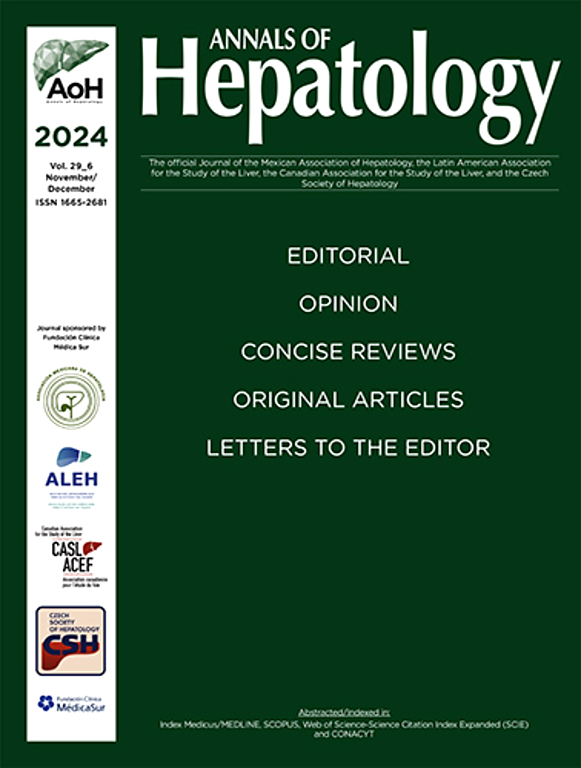Surveillance and management of hepatocellular carcinoma after treatment of hepatitis C with direct-acting antiviral drugs
IF 3.7
3区 医学
Q2 GASTROENTEROLOGY & HEPATOLOGY
引用次数: 0
Abstract
Hepatitis C virus (HCV) belongs to the Flaviviridae family, and is a single-stranded RNA virus with positive polarity. It is the primary cause of hepatocellular carcinoma (HCC) worldwide. The treatment of HCV has entered a new era with the advent of direct-acting antiviral drugs (DAAs) and is associated with cure rates of more than 95 %, making HCV the only curable viral disease. The successful treatment of chronic hepatitis C has greatly reduced, but not eliminated, the risk of HCC. Certain individuals, especially those with cirrhosis already present, remain vulnerable to HCC after achieving a sustained virological response (SVR). This article systematically reviews the recent studies on the risk and mechanisms of HCC development after HCV viral cure, the screening and predictive value of biological markers, and patient surveillance. Factors such as older age, diabetes, hepatic fat accumulation, alcohol use, and lack of fibrosis reversal are linked to increased HCC risk after HCV cure. The mechanism of HCC development after DAAs treatment remains unclear, but the possible mechanisms include immune cell dysfunction during HCV infection, cytokine network imbalance, epigenetic alterations, and host factors. Several biological markers and risk prediction models have been used to monitor the risk of HCC in CHC patients who have achieved SVR, but most still require validation and standardization. The implementation of risk-stratified surveillance programs is becoming urgent from a cost-effective point of view, but the availability of validated biomarkers to predict HCC in cured patients remains an unmet clinical need. Additionally, managing CHC patients who achieve SVR is becoming a growing challenge as an increasing number of HCV patients are cured.
使用直接作用抗病毒药物治疗丙型肝炎后肝细胞癌的监控和管理。
丙型肝炎病毒(HCV)属于黄病毒科,是一种具有正极性的单链 RNA 病毒。它是全球肝细胞癌(HCC)的主要病因。随着直接作用抗病毒药物(DAAs)的出现,HCV 的治疗进入了一个新时代,治愈率超过 95%,使 HCV 成为唯一可治愈的病毒性疾病。慢性丙型肝炎的成功治疗大大降低了患 HCC 的风险,但并没有消除这种风险。某些患者,尤其是已经出现肝硬化的患者,在获得持续病毒学应答(SVR)后仍然很容易发生 HCC。本文系统回顾了近期关于HCV病毒治愈后HCC发生的风险和机制、生物标记物的筛查和预测价值以及患者监测的研究。高龄、糖尿病、肝脏脂肪堆积、饮酒和纤维化未逆转等因素与HCV治愈后HCC风险增加有关。DAAs治疗后发生HCC的机制仍不清楚,但可能的机制包括HCV感染期间免疫细胞功能失调、细胞因子网络失衡、表观遗传学改变和宿主因素。一些生物标记物和风险预测模型已被用于监测获得 SVR 的 CHC 患者的 HCC 风险,但大多数仍需要验证和标准化。从成本效益的角度来看,实施风险分级监测计划已变得迫在眉睫,但提供有效的生物标志物来预测治愈患者的 HCC 仍是一项尚未满足的临床需求。此外,随着越来越多的 HCV 患者被治愈,如何管理获得 SVR 的 CHC 患者正成为一项日益严峻的挑战。
本文章由计算机程序翻译,如有差异,请以英文原文为准。
求助全文
约1分钟内获得全文
求助全文
来源期刊

Annals of hepatology
医学-胃肠肝病学
CiteScore
7.90
自引率
2.60%
发文量
183
审稿时长
4-8 weeks
期刊介绍:
Annals of Hepatology publishes original research on the biology and diseases of the liver in both humans and experimental models. Contributions may be submitted as regular articles. The journal also publishes concise reviews of both basic and clinical topics.
 求助内容:
求助内容: 应助结果提醒方式:
应助结果提醒方式:


